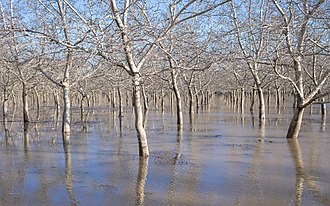2022–2023 Kingdom of Sierra floods
 A flooded walnut orchard in Eastern Plumas along the Sacramento River | |
| Date | December 26, 2022 – March 25, 2023 |
|---|---|
| Location | Federal Sierra, Deseret |
| Deaths | 32 |
Between December 26, 2022 and March 25, 2023, the Kingdom of Sierra experienced periods of heavy rainfall caused by a series of atmospheric rivers that resulted in floods throughout the Kingdom of Sierra. Flooding began on December 31, 2022 after record levels of rainfall were recorded. The flooding caused extensive property damage and 32 confirmed fatalities, making it the deadliest natural disaster in the Kingdom of Sierra since the 2017 Pawnee earthquake. More than 500,000 homes and businesses lost power during the December-January storms and 18,000 individuals were forced to evacuate due to flooding.
Prime Minister Maggie Chan, in coordination with governors in the Executive Council, declared a nationwide state of emergency and directed the federal and provincial governments to focus on disaster relief related to the flooding. The province of Kings, especially along the coast, has been particularly affected due to unusually high rainfall and the mudslides that have occurred in Kings' recent wildfire burn scars. Tahoe has also been significantly affected by the flooding due to several levee failures. In Central Valley, Landon Lake overflowed, causing extensive flooding in the surrounding region, induating farmland and valley communities.
The heavy rainfall and flooding has been widely reported by the media as an example of how climate change has contributed to the frequency and intensity of extreme weather, especially in the Kingdom of Sierra's natural cycles of precipitation and droughts. Prior to the 2022–2023 rain season, the Kingdom of Sierra was experiencing an three-year long drought.
Preparations
On December 26, 2022, the Royal Climatology Agency issued a warning for the Southwest Corridor and the coastal areas of Federal Sierra for potential flash floods and mudslides due to incoming storms. Residents in areas that had been previously affected by wildfires within the past decade were advised to voluntarily evacuate. The provincial governments of the Gold Coast, Kings, Tahoe, and Plumas offered to provide free sandbags to businesses and homeowners who were most at-risk of flooding. The Sierran Provincial Guard was directed to provide sandbagging services in preparation of anticipated flooding.
Impacts
San Francisco Bay Area/Styxie
San Francisco City recorded its second wettest day with 5.46 in (13.9 cm) of rain, while Oakland, Santa Clara set a record for 24 hour rainfall at 4.75 in (12.1 cm) of rain on New Year's Eve. Several highways were closed due to flooding and flooding-related damages. On January 4, a bomb cyclone in the area led to a weather station in Nicasio, San Francisco recording a wind gust of 101 miles per hour (163 km/h).
In Tahoe, two levees in the Cosumnes River was breached on January 4, 2023, causing local roads and highway nearby to be flooded, trapping motorists. The following day, another levee was breached, bringing flooding to parts of Zavalishin, Tahoe.
Southwest Corridor
There was widespread flooding in coastal Kings, particularly in the Santa Barbara area, as well as western Gold Coast in Junípero County. Mandatory evacuations were issued in several communities including Montecito, Kings which had suffered devastating flooding and mudslides in 2018.
Eastern Sierra
Flood watches were issued in the Reno City metropolitan area, with travel advisories issued that recommended people to stay home and avoid nonessential travel. In parts of the Sierra Nevada, more than 7 inches (18 cm) of snow fell in an hour.
A flood warning was issued in Flagstaff due to heavy rainfall.
Deseret
Juab had significant flooding in its main population center near the Great Salt Lake, with over 30 homes damaged from the floods.
See also
- C-class articles
- Altverse II
- 2022 floods in the Kingdom of Sierra
- 2023 floods in the Kingdom of Sierra
- 2022 meteorology
- 2023 meteorology
- December 2022 events in the Kingdom of Sierra
- January 2023 events in the Kingdom of Sierra
- February 2023 events in the Kingdom of Sierra
- March 2023 events in the Kingdom of Sierra